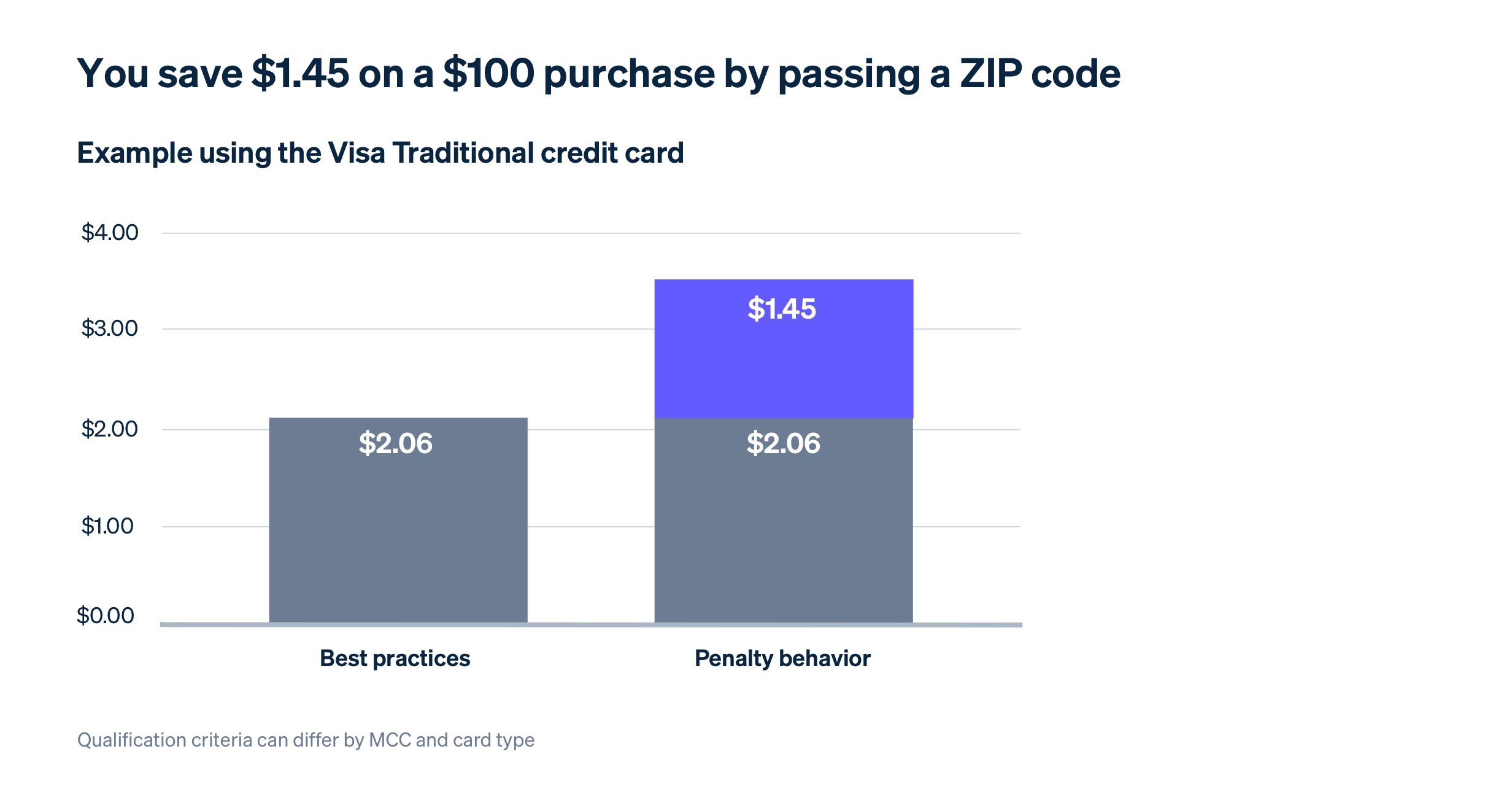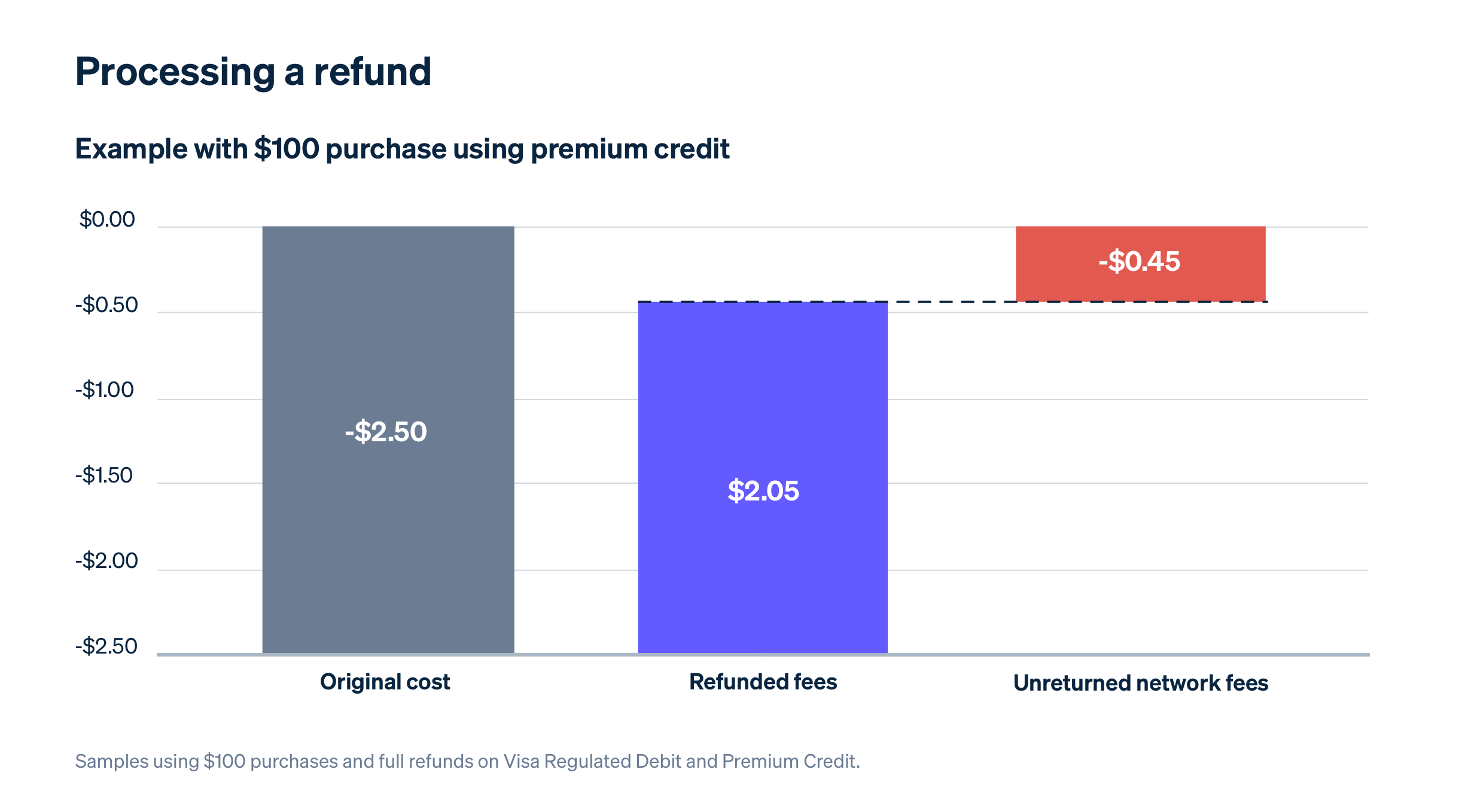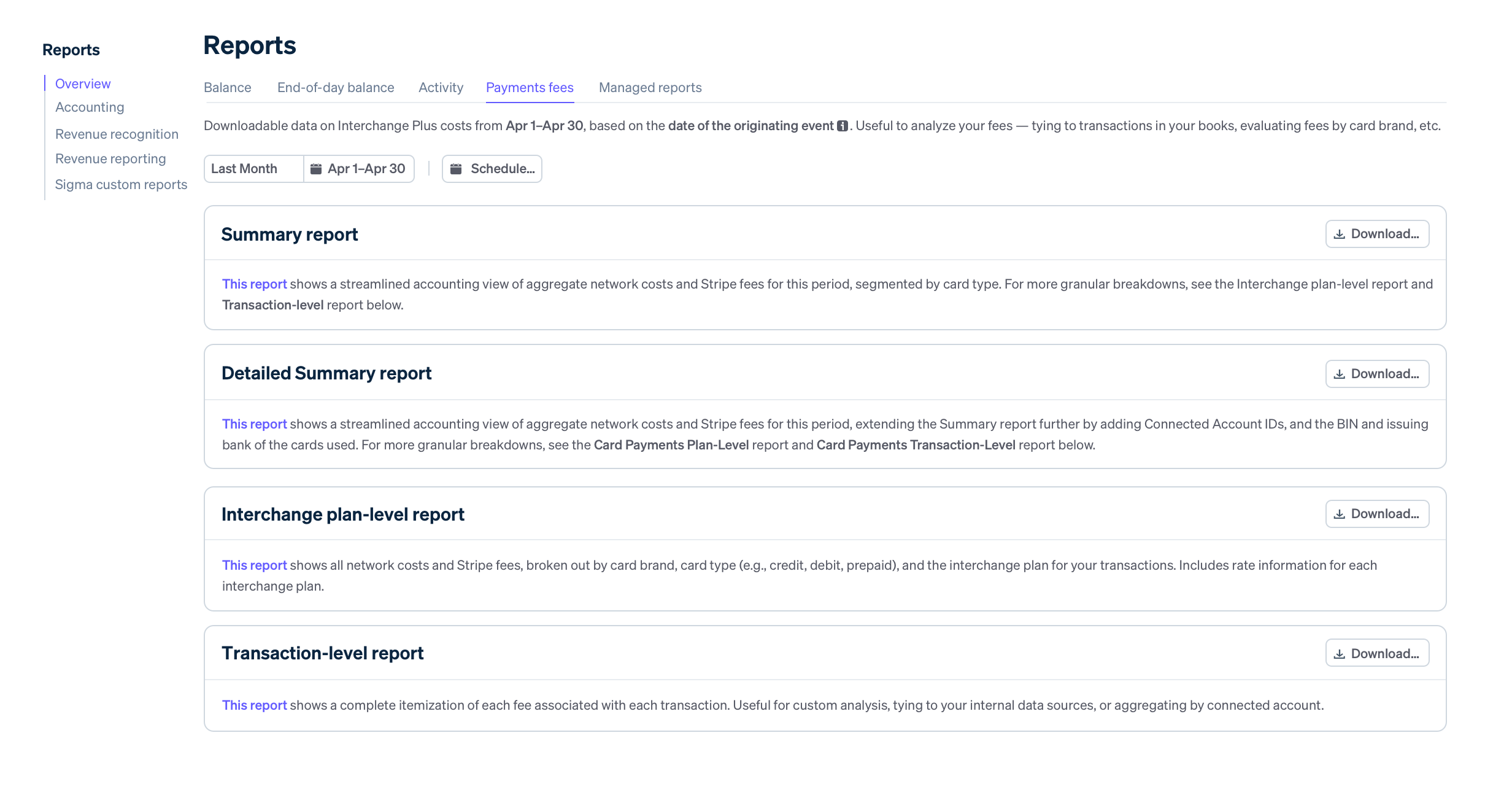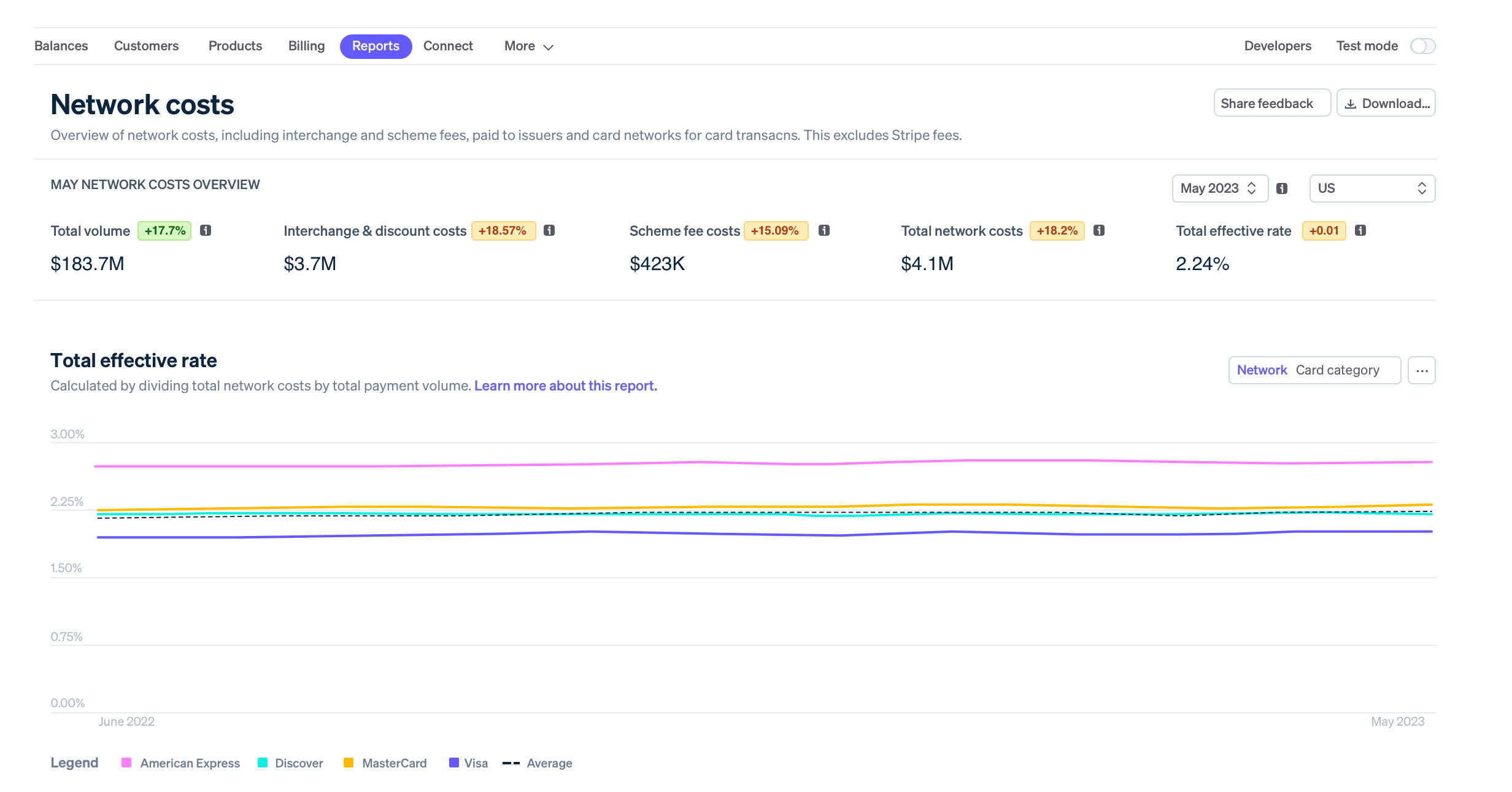เมื่อธุรกิจของคุณเติบโตขึ้น การเปลี่ยนจากค่าบริการแบบอัตราคงที่มาเป็นรูปแบบราคาบวกต้นทุนของเครือข่ายอาจเพิ่มความยืดหยุ่นและลดค่าใช้จ่ายได้ นอกจากนี้ รูปแบบราคาบวกต้นทุนของเครือข่าย หรือที่บางครั้งที่เรียกว่าราคาบวกค่าธุรกรรมผ่านบัตรระหว่างธนาคาร ยังช่วยเพิ่มความโปร่งใสให้กับค่าธรรมเนียมต่างๆ ที่เกี่ยวข้องกับธุรกรรมแต่ละรายการด้วย เมื่อมีรายละเอียดในระดับนี้ คุณอาจมีโอกาสระบุและทำการปรับเปลี่ยนต่อปัจจัยที่สำคัญที่สุดซึ่งส่งผลต่อค่าใช้จ่าย อย่างไรก็ตาม โอกาสนี้ยังมาพร้อมกับความคาดเดาไม่ได้และความซับซ้อน: ปัจจัยที่ส่งผลต่อค่าใช้จ่ายเครือข่ายมีความผันผวน คาดการณ์ได้ยาก และอาจมีการเปลี่ยนแปลงโดยเครือข่ายบัตร
คู่มือนี้จะช่วยคุณรับมือกับความซับซ้อนที่เกี่ยวข้องกับค่าใช้จ่ายสําหรับเครือข่ายของธุรกรรมออนไลน์ คุณจะได้ศึกษาเกี่ยวกับค่าธรรมเนียมต่างๆ ที่เกี่ยวข้องกับธุรกรรมออนไลน์ รวมถึงขั้นตอนที่สามารถดําเนินการเพื่อลดค่าใช้จ่ายดังกล่าว และวิธีที่ Stripe จะช่วยคุณได้
แม้เคล็ดลับบางส่วนเหล่านี้อาจส่งผลให้ประหยัดค่าใช้จ่าย แต่เคล็ดลับบางประการก็อาจไม่เหมาะกับธุรกิจของคุณ ขณะที่ประเมินโอกาสเหล่านี้ คุณควรพิจารณาอุตสาหกรรม ภูมิภาค ปริมาณการชําระเงิน การผสมผสานบัตร และลูกค้าของคุณเพื่อทําความเข้าใจว่าโอกาสต่างๆ จะส่งผลอย่างไรกับผลกําไรของคุณ ตัวอย่างเช่น บริษัทแบบ B2B ที่ประมวลผลธุรกรรมผ่านบัตรองค์กรจะมีโอกาสประหยัดต้นทุนมากขึ้นเมื่อเทียบกับธุรกิจแบบ B2C การเปลี่ยนแปลงอาจจะกําหนดให้ต้องมีการลงทุนทางวิศวกรรมหรือการเปลี่ยนแปลงประสบการณ์ของลูกค้าเล็กน้อย เช่น การรวบรวมรายละเอียดเพิ่มเติม แล้วส่งผ่านในระหว่างการทําธุรกรรม ทั้งนี้ จะขึ้นอยู่กับการตั้งค่าของธุรกิจและการผสานการชําระเงินของคุณ
ข้อมูลพื้นฐานเกี่ยวกับการชําระเงิน
ก่อนที่จะสำรวจปัจจัยที่มีอิทธิพลต่อค่าใช้จ่ายสําหรับเครือข่าย การมีความเข้าใจภาพรวมเกี่ยวกับวิธีทํางานของการชําระเงินออนไลน์ อาทิ วิธีรับส่งเงินจากลูกค้าไปยังธุรกิจของคุณ รวมถึงวิธีที่ธนาคารอํานวยความสะดวกในการชําระเงินเหล่านี้ จะเป็นสิ่งที่มีประโยชน์ การเรียนรู้เกี่ยวกับชุดโครงสร้างพื้นฐานเหล่านี้จะช่วยให้คุณเข้าใจค่าใช้จ่ายที่เกี่ยวข้องในระบบนี้และโอกาสในการลดค่าใช้จ่ายดังกล่าวได้ดีขึ้น
ผู้เกี่ยวข้องที่สำคัญในการทำธุรกรรมออนไลน์แต่ละรายการมีดังนี้
- ผู้ถือบัตร: บุคคลที่ใช้บัตรเครดิตหรือบัตรเดบิต ในนามของตัวเองหรือธุรกิจ
- ธุรกิจ: นิติบุคคลที่รับการชําระเงินผ่านบัตร
- บริษัทผู้รับบัตร: สถาบันการเงินที่ประมวลผลการชําระเงินผ่านบัตรในนามของธุรกิจและกำหนดเส้นทางเงินผ่านเครือข่ายบัตรไปยังสถานบันผู้ออกบัตร บางครั้งบริษัทผู้รับบัตรอาจเป็นพาร์ทเนอร์กับบริษัทภายนอกเพื่อช่วยประมวลผลการชำระเงิน
- บริษัทผู้ออกบัตร: สถาบันการเงินที่ให้บริการด้านธนาคารหรือธุรกรรม และออกบัตรชําระเงิน (เช่น บัตรเครดิตหรือบัตรเดบิต) ให้แก่ผู้บริโภคหรือธุรกิจต่างๆ ในนามของเครือข่ายบัตร
- เครือข่ายบัตร: เครือข่ายบัตร เช่น Visa และ Mastercard เป็นตัวเชื่อมต่อระหว่างฝ่ายที่เกี่ยวข้องเหล่านี้ทั้งหมด โดยจะสื่อสารข้อมูลธุรกรรม รับส่งเงินธุรกรรม และกําหนดค่าธรรมเนียมเครือข่ายสําหรับธุรกรรมผ่านบัตร
ค่าธรรมเนียมเครือข่ายที่มาพร้อมกับธุรกรรมแต่ละรายการ ซึ่งดําเนินการผ่านระบบห้าฝ่ายนี้นั้นมีหลายประการ Visa, Mastercard และเครือข่ายบัตรอื่นๆ จะเป็นผู้กําหนดค่าธรรมเนียมเครือข่ายซึ่งรวมถึงค่าธรรมเนียมธุรกรรมผ่านบัตรระหว่างธนาคารและค่าธรรมเนียมเครือข่ายบัตร American Express ใช้โมเดลที่ต่างกันเล็กน้อยเนื่องจากเป็นทั้งผู้รับบัตร เครือข่าย และผู้ออกบัตร โดยค่าใช้จ่ายสําหรับเครือข่ายของบริษัทนี้จะเรียกว่าอัตราส่วนลด
ปกติแล้ว ธุรกรรมผ่านบัตรระหว่างธนาคารจะเป็นชุดค่าใช้จ่ายสําหรับเครือข่าย โดยจะต้องชำระค่าใช้จ่ายนี้ให้บริษัทผู้ออกบัตร เนื่องจากเป็นผู้ออกบัตรให้แก่ผู้บริโภคและธุรกิจ แล้วเพิ่มลูกค้าเข้าสู่ระบบ เครือข่ายบัตรจะเรียกเก็บค่าธรรมเนียมเครือข่ายบัตรเอง ซึ่งอาจรวมถึงค่าธรรมเนียมการอนุมัติเพิ่มเติมและค่าธรรมเนียมธุรกรรมข้ามพรมแดนด้วย นอกจากนี้ ยังอาจคิดค่าธรรมเนียมการคืนเงินและบริการเครือข่ายอื่นๆ ด้วย
ปัจจัยที่ส่งผลต่อค่าใช้จ่ายสําหรับเครือข่าย
ไม่มีวิธีที่ครอบจักรวาลในการจัดการค่าใช้จ่ายสําหรับเครือข่าย ค่าธรรมเนียมเหล่านี้จะแตกต่างกันไปในธุรกรรมแต่ละรายการ บัตรแต่ละใบ ไปจนถึงธุรกิจแต่ละแห่ง ตัวอย่างเช่น การชําระเงินด้วยบัตรเครดิตสะสมรางวัลมีแนวโน้มที่จะมีค่าธรรมเนียมเครือข่ายสูงกว่าธุรกรรมที่ใช้บัตรเครดิตรูปแบบอื่น เนื่องจากบริษัทผู้ออกบัตรมักจะใช้ค่าธรรมเนียมเหล่านี้มาหักลบกับค่าใช้จ่ายของโปรแกรมสะสมรางวัล
ปัจจัยต่างๆ ที่ส่งผลกระทบต่อค่าใช้จ่ายสําหรับเครือข่ายมีดังนี้
- ขนาดของธุรกรรม
- ประเภทบัตรที่ใช้
- รหัสหมวดหมู่ผู้ค้า (MCC)
- สถานที่ที่ธุรกิจของคุณตั้งอยู่
- สถานที่ที่บริษัทผู้ออกบัตรตั้งอยู่
- วิธีประมวลผลการชําระเงิน (เช่น ที่จุดขาย ทางออนไลน์ หรือทางโทรศัพท์)
- มีการใช้โทเค็นเครือข่ายในธุรกรรมหรือไม่
วิธีจัดการค่าใช้จ่ายสําหรับเครือข่าย
ในขณะที่ปัจจัยส่วนใหญ่ที่ส่งผลต่อค่าใช้จ่ายสําหรับเครือข่ายไม่ใช่สิ่งที่คุณควบคุมได้ แต่ก็มีหลายวิธีที่คุณสามารถส่งอิทธิพลต่อค่าใช้จ่ายได้ โดยเฉพาะอย่างยิ่ง เพื่อลดค่าธรรมเนียมธุรกรรมผ่านบัตรระหว่างธนาคารที่คุณอาจต้องชําระ หัวข้อนี้จะครอบคลุมโอกาส 4 รูปแบบในการจัดการค่าใช้จ่ายสําหรับเครือข่าย ซึ่งมีดังนี้
- ส่งผ่านข้อมูลธุรกรรมไปยังบริษัทผู้ออกบัตรมากขึ้น
- รหัสไปรษณีย์
- ข้อมูลระดับ 2 (ภาษีการขาย) และระดับ 3 (รายละเอียดการขาย)
- รหัสไปรษณีย์
- เปิดใช้โทเค็นเครือข่าย
- ใช้บริการภายในประเทศ
- ทำการเปลี่ยนแปลงประสบการณ์ของลูกค้าในส่วนอื่นๆ
1. ส่งผ่านข้อมูลธุรกรรมไปยังบริษัทผู้ออกบัตรมากขึ้น
ข้อมูลอื่นๆ ของเจ้าของบัตรที่คุณสามารถส่งผ่านให้ผู้ออกบัตรอาจเป็นสิ่งที่มีค่าและช่วยให้ตรวจสอบได้ว่าธุรกรรมนั้นถูกต้องหรือไม่ ซึ่งอาจทําให้คุณเสียค่าธรรมเนียมน้อยลง โดยเฉพาะอย่างยิ่งข้อมูล 2 ประการ ซึ่งได้แก่ รหัสไปรษณีย์และข้อมูลระดับ 2 หรือระดับ 3 อาจส่งผลต่อการลดต้นทุนอย่างมีนัยสําคัญ
รหัสไปรษณีย์
คุณสามารถประหยัดได้ถึง $1.45 สำหรับธุรกรรม $100 ด้วยการส่งผ่านรหัสไปรษณีย์
การเก็บข้อมูลรหัสไปรษณีย์ของลูกค้าระหว่างการชําระเงินและรวมไว้ในข้อมูลธุรกรรมอาจเป็นหนึ่งในปัจจัยที่มีผลที่สุดต่อค่าธรรมเนียมการทําธุรกรรมผ่านบัตรระหว่างธนาคาร โดยช่วยให้ชําระเงินในอัตราที่ต่ําลง คุณสามารถลดค่าใช้จ่ายสําหรับเครือข่ายได้ถึง 1.45% ของยอดธุรกรรมโดยการส่งรหัสไปรษณีย์ให้บริษัทผู้ออกบัตร ทั้งนี้ ขึ้นอยู่กับประเภทของบัตร สําหรับ Visa และ Discover การส่งรหัสไปรษณีย์ยังช่วยให้คุณหลีกเลี่ยงค่าใช้จ่ายที่สูงขึ้นด้วย โดยทั้งสองบริษัทจะคิดค่าธรรมเนียมเพิ่มเติมหากไม่ระบุรหัสไปรษณีย์

ในขณะที่การส่งผ่านข้อมูลรหัสไปรษณีย์เป็นวิธีที่ค่อนข้างง่ายในการลดค่าใช้จ่าย แต่อาจใช้ไม่ได้กับธุรกิจทุกแห่งในทุกอุตสาหกรรม นอกจากนี้ การบังคับใช้ข้อกําหนดเพิ่มเติมในกระบวนการชําระเงินยังอาจเพิ่มความยุ่งยากและลดอัตราการเปลี่ยนเป็นผู้ใช้แบบชําระเงิน ติดต่อผู้จัดการฝ่ายดูแลลูกค้าของคุณหรือฝ่ายขายของเรา หากอยากทราบว่าธุรกิจของคุณมีสิทธิ์รับส่วนลดหรือไม่เมื่อส่งผ่านข้อมูลรหัสไปรษณีย์
การดําเนินการที่คุณทําได้มีดังนี้ ตรวจสอบขั้นตอนการชําระเงินของคุณเอง และตรวจสอบว่าได้ตั้งค่าแบบฟอร์มการชําระเงินทั้งหมด (บนเดสก์ท็อป อุปกรณ์เคลื่อนที่ หรือผ่านกระเป๋าเงินดิจิทัล) เพื่อให้เจ้าของบัตรป้อนรหัสไปรษณีย์
ข้อมูลระดับ 2 และระดับ 3
คุณสามารถประหยัดเงินได้สูงสุดถึง $0.80 จากธุรกรรมผ่านบัตรองค์กร $100 ด้วยการส่งข้อมูลระดับ 2 และระดับ 3
ธุรกิจบางแห่งที่ทำการขายแบบ B2B อาจได้รับประโยชน์จากการส่งผ่านข้อมูลประเภทอื่นๆ โดยเราจะเรียกข้อมูลประเภทนี้ว่าข้อมูลระดับ 2 และระดับ 3
ข้อมูลระดับ 2 เป็นข้อมูลภาษีการขายเป็นหลัก และหากส่งต่อให้บริษัทผู้ออกบัตรในข้อความธุรกรรม ก็อาจลดค่าใช้จ่ายได้ถึง $0.50–$0.75 สําหรับธุรกรรมมูลค่า $100 (ขึ้นอยู่กับประเภทบัตร) แต่หากไม่เรียกเก็บภาษีการขายเป็นบรรทัดรายการ คุณจะไม่มีสิทธิ์ได้รับอัตราส่วนลดเหล่านี้
ข้อมูลระดับ 3 คือข้อมูลแบบละเอียดเกี่ยวกับการขาย ซึ่งช่วยให้ผู้ออกบัตรเข้าใจว่าธุรกรรมที่ทํากับธุรกิจ บัตรองค์กร หรือบัตรเพื่อการจัดซื้อนั้นมีคุณสมบัติตรงตามเกณฑ์สําหรับค่าใช้จ่ายของธุรกิจหรือไม่ และช่วยให้คุณมีสิทธิ์รับอัตราค่าธรรมเนียมการทําธุรกรรมผ่านบัตรระหว่างธนาคารที่ต่ําลงเมื่อเทียบกับข้อมูลระดับ 2 นอกจากนี้ ข้อมูลระดับ 3 ยังระบุคําอธิบายของสินค้าที่ซื้อ จํานวนหน่วยที่ซื้อ หน่วยวัด และอื่นๆ ให้บริษัทผู้ออกบัตรทราบ ตัวอย่างเช่น สมมติว่าธุรกิจส่งพนักงานของตนไปยังงานประชุม และใช้บัตรธุรกิจเพื่อทําธุรกรรมในคาสิโน บริษัทผู้ออกบัตรจะทราบได้อย่างไรว่าค่าใช้จ่ายนี้เป็นอาหารค่ําสําหรับธุรกิจหรือใช้เพื่อการพนัน และควรอนุมัติค่าใช้จ่ายหรือไม่ ข้อมูลระดับที่ 3 จะบอกผู้ออกบัตรว่าสิ่งที่ซื้อคืออะไร ไม่ว่าจะเป็นสเต็ก 2 จานสำหรับมื้อค่ำหรือชิปคาสิโนมูลค่า $50 เมื่อระบุข้อมูลระดับ 3 ธุรกรรมมูลค่า $100 เดียวกันอาจมีสิทธิ์รับส่วนลดได้ถึง $0.80
การดําเนินการที่คุณทําได้มีดังนี้ ดูปริมาณการชําระเงินของคุณเพื่อหาจํานวนธุรกรรมที่ทํากับธุรกิจ การจัดซื้อ และบัตรเพื่อการค้า และตรวจสอบว่าคุณมีสิทธิ์รับอัตราค่าที่ต่ําลงเหล่านี้หรือไม่ สําหรับธุรกิจที่มีสัดส่วนการทําธุรกรรมผ่านบัตร B2B สูง Stripe จะช่วยให้คุณส่งข้อมูลระดับ 2 และระดับ 3 ไปยังเครือข่ายเพื่อลดค่าใช้จ่ายได้ง่ายๆ ติดต่อผู้จัดการบัญชีของคุณหรือฝ่ายขายของเรา เพื่อขอข้อมูลเพิ่มเติม
2. เปิดใช้โทเค็นเครือข่าย
โทเค็นเครือข่ายคือข้อมูลประจําตัวสําหรับการชําระเงินที่สามารถใช้แทน PAN สําหรับการซื้อสินค้าออนไลน์ โทเค็นเครือข่ายช่วยให้มั่นใจว่าระบบจะนําข้อมูลประจําตัวล่าสุดมาใช้กับการชําระเงินของคุณ หาก PAN ที่เกี่ยวข้องกับโทเค็นเครือข่ายมีการเปลี่ยนแปลงหรือหมดอายุ โทเค็นจะยังคงเป็นปัจจุบันและใช้งานได้ นอกเหนือจากสิทธิประโยชน์ด้านอัตราส่วนลดแล้ว โทเค็นเครือข่ายยังช่วยลดค่าใช้จ่ายสําหรับเครือข่ายของผู้ใช้ที่รูปแบบราคาบวกต้นทุนของเครือข่าย โดยการปรับใช้อัตราที่ต่ําลงจากเครือข่ายบัตรด้วย ดูข้อมูลเพิ่มเติมเกี่ยวกับวิธีการทํางานของโทเค็นเครือข่าย

3. ใช้บริการภายในประเทศ
ค่าใช้จ่ายสําหรับเครือข่ายเพิ่มขึ้นเมื่อคุณขยายธุรกิจไปทั่วโลกและประมวลผลธุรกรรมจากเจ้าของบัตรต่างประเทศมากขึ้น บัตรที่ออกนอกประเทศของคุณจะใช้โครงสร้างอัตราค่าธรรมเนียมธุรกรรมผ่านบัตรระหว่างธนาคารที่ต่างกันและมีการเรียกเก็บค่าธรรมเนียมเครือข่ายข้ามพรมแดนเพิ่มเติม อย่างไรก็ตาม หากคุณสามารถประมวลผลการเรียกเก็บเงินเหล่านี้เป็นธุรกรรมภายในประเทศ ก็อาจประหยัดได้สูงสุด $1.00 ต่อธุรกรรม $100 เงินที่ประหยัดได้อาจสูงยิ่งกว่านี้ โดยจะขึ้นอยู่กับสกุลเงินที่ใช้ชําระเงินและประเภทบัตร
สมมติว่าธุรกิจของคุณอยู่ในสหรัฐอเมริกาและมีคนซื้อสินค้าด้วยบัตรเครดิตที่ออกในเยอรมนี ธุรกรรมระหว่างประเทศที่แท้จริงจะเป็นดังนี้: ธุรกรรมนี้เกิดขึ้นในสหรัฐอเมริกาด้วยบัตรที่ออกนอกสหรัฐอเมริกา ด้วยเหตุนี้ ธุรกรรมนี้จึงจะมีค่าธรรมเนียมข้ามพรมแดนมากกว่า 1% ในท้ายที่สุด คุณอาจเปิดสํานักงานในเยอรมนีเพื่อสนับสนุนตลาดที่กําลังเติบโตนี้ แต่ธุรกรรมทั้งหมดของคุณจะยังคงดำเนินการผ่านตำแหน่งที่ตั้งในสหรัฐอเมริกาและจะยังคงเสียค่าธรรมเนียมเพิ่มเติม
การซื้อกิจการในภูมิภาคที่ลูกค้าอาศัยอยู่จะมีค่าใช้จ่ายน้อยกว่า เนื่องจากคุณสามารถใช้อัตราภายในประเทศและหลีกเลี่ยงค่าธรรมเนียมธุรกรรมข้ามพรมแดนได้ ในกรณีนี้ การเปิดตัวนิติบุคคล ตำแหน่งที่ตั้ง และบัญชีธนาคารในเยอรมนีอาจทำให้ค่าธรรมเนียมธุรกรรมสําหรับบัตรเยอรมนีที่ดําเนินการโดยนิติบุคคลในเยอรมนีนั้นลดลงได้มากถึง 1%
ทุกประเทศมีอัตราค่าธรรมเนียมธุรกรรมผ่านบัตรระหว่างธนาคารที่แตกต่างกัน ดังนั้นคุณอาจเห็นส่วนลดเพิ่มขึ้น (โดยเฉพาะในยุโรป ซึ่งมีการกำกับดูแลธุรกรรมผ่านบัตรระหว่างธนาคาร) แต่จะขึ้นอยู่กับว่าคุณขยายธุรกิจไปที่ใด
การดําเนินการที่คุณทําได้มีดังนี้ Stripe ช่วยให้การขยายตลาดไปต่างประเทศเป็นเรื่องง่ายด้วยบริการที่รองรับในกว่า 45 ประเทศ หากคุณมีตําแหน่งที่ตั้งที่รองรับการขายสินค้าหรือบริการในประเทศและประมวลผลธุรกรรมจํานวนมากบนบัตรที่ออกในประเทศเหล่านี้ คุณควรเปิดบัญชี Stripe เพิ่มเติมในประเทศเหล่านี้ เพื่อลดค่าใช้จ่ายในการชําระเงินด้วยบัตร
นอกจากนี้ Stripe ยังช่วยให้ธุรกิจต่างๆ เสนอวิธีการชําระเงินระหว่างประเทศที่ได้รับความนิยมทั่วโลกได้โดยไม่ต้องสร้างบัญชีต่างประเทศ อ่านคู่มือเกี่ยวกับวิธีการชําระเงินระหว่างประเทศ เพื่อเรียนรู้วิธีเพิ่มอัตราการเปลี่ยนเป็นผู้ใช้แบบชําระเงินและมอบสิทธิประโยชน์อื่นๆ
4. การเปลี่ยนแปลงประสบการณ์ของลูกค้าในส่วนอื่นๆ
ลองเปลี่ยนวิธีประมวลผลการคืนเงินและจัดการธุรกรรมขนาดเล็กจากลูกค้ารายหนึ่ง คุณสามารถทําการเปลี่ยนแปลงเหล่านี้โดยอ้อมได้ (เช่น การอัปเดตวิธีการอนุมัติและชําระธุรกรรม) เพื่อลดต้นทุน รวมทั้งหลีกเลี่ยงผลกระทบโดยตรงต่อประสบการณ์ของลูกค้า
กำหนดสถานะการอนุมัติเป็นเปิดไว้
การคืนเงินสําหรับธุรกรรม $100 อาจมีค่าใช้จ่ายสูงถึง 24 เท่า เมื่อเทียบกับการปรับคืนการอนุมัติ
เมื่อคุณประมวลผลการคืนเงิน โดยปกติแล้วคุณจะได้รับค่าธรรมเนียมธุรกรรมผ่านบัตรระหว่างธนาคารน้อยกว่าที่คุณชำระในตอนแรก ตัวอย่างเช่น หากลูกค้าส่งคืนสินค้า/บริการที่มีการซื้อด้วยบัตรเครดิตมูลค่า $100 เครือข่ายอาจคืนเงินค่าธรรมเนียม $2.05 จากยอดค่าธรรมเนียม $2.50 ในตอนแรก และทําให้คุณเสียเงิน $0.45

การซื้อด้วยบัตรเดบิตในสหรัฐฯ อาจมีผลกระทบมากยิ่งกว่า โดยจะไม่มีการคืนค่าธรรมเนียมธุรกรรมผ่านบัตรระหว่างธนาคารสําหรับธุรกรรมผ่านบัตรเดบิตในสหรัฐอเมริกา
หากธุรกิจของคุณมักจะประมวลผลการคืนเงินในไม่ช้าหลังจากชําระเงิน คุณสามารถวางแผนรับมือกับโอกาสในการสูญเสียค่าธรรมเนียมเหล่านี้ได้โดยการกำหนดสถานะการอนุมัติธุรกรรมเหล่านี้เป็นเปิดอยู่ แทนที่จะชำระเงินสำหรับการขายในทันที คุณสามารถทำเช่นนี้ได้เนื่องจากคุณจะจ่ายค่าธรรมเนียมธุรกรรมผ่านบัตรระหว่างธนาคารก็ต่อเมื่อมีการชําระธุรกรรมผ่านบัตรระหว่างธนาคารแล้วเท่านั้น หากคุณเปิดการอนุมัติไว้และลูกค้าทํารายการคืนสินค้า คุณก็สามารถปรับคืนการอนุมัติได้ง่ายๆ และหลีกเลี่ยงการเสียค่าธรรมเนียมการทําธุรกรรมบัตรระหว่างธนาคาร (เนื่องจากคุณยังไม่ได้จ่ายค่าธรรมเนียมดังกล่าว)
ตัวอย่างเช่น หากคุณหักยอดและชําระหนี้ธุรกรรมบัตรเดบิตมูลค่า $100 และลูกค้าขอคืนสินค้า คุณอาจเสียเงิน $0.42 แต่หากคุณเปิดการอนุมัติไว้ ก็อาจสูญเสียเงินไม่เกิน $0.04 เท่านั้น
โดยทั่วไปแล้ว คุณสามารถเปิดการอนุมัติวงเงินไว้ได้สูงสุด 2 วันก่อนที่คุณจะจ่ายค่าธรรมเนียมเพิ่มเติม ดังนั้นวิธีนี้จึงเหมาะกับอุตสาหกรรมที่จัดส่งสินค้าในทันที (เช่น บริการจัดส่งอาหาร)
การดําเนินการที่คุณทําได้มีดังนี้ กําหนดค่า Stripe Payment Intents API เพื่อแยกการอนุมัติและการหักยอด
เพิ่มประสิทธิภาพธุรกรรมยอดเล็ก
ลดค่าธรรมเนียมคงที่ด้วยการอนุมัติแบบเพิ่มวงเงิน
การประมวลผลธุรกรรมยอดเล็กหลายรายการ เช่น การชําระเงินมูลค่า $5 หรือน้อยกว่านั้นอาจเพิ่มค่าใช้จ่ายโดยรวมของคุณได้อย่างรวดเร็ว แม้ค่าธรรมเนียมการทําธุรกรรมผ่านบัตรระหว่างธนาคารจะน้อยกว่าสําหรับการชําระเงินเหล่านี้ แต่ก็ยังคิดเป็นสัดส่วนจำนวนหนึ่งจากธุรกรรมโดยรวม
หากคุณคาดว่ามูลค่าธุรกรรมจะเปลี่ยนแปลงเล็กน้อย (เช่น ทิปที่เพิ่มเข้ามาจากการเรียกเก็บเงินพื้นฐาน) ให้กำหนดสถานะการอนุมัติเป็นเปิดไว้จนกว่าคุณจะสรุปจํานวนทั้งหมดได้ การทำเช่นนี้จะช่วยให้คุณหักยอดการชําระเงินเพียงครั้งเดียวและจ่ายค่าธรรมเนียมน้อยลงเพื่อเปลี่ยนแปลงยอดการอนุมัติเมื่อเทียบกับการสร้างธุรกรรมรายการใหม่ทุกครั้ง การอนุมัติแบบเพิ่มวงเงินใช้ได้กับบางเครือข่ายเท่านั้น ติดต่อผู้จัดการบัญชีของคุณหรือฝ่ายขายของเรา เพื่อขอข้อมูลเพิ่มเติม
Stripe จะช่วยได้อย่างไร
การเพิ่มประสิทธิภาพต้นทุนนั้นมีความหลากหลาย โดยธุรกิจบางแห่งอาจต้องการทําการเปลี่ยนแปลงเพิ่มเล็กน้อยเท่านั้น ในขณะที่ธุรกิจอื่นอาจต้องการปรับใช้การเพิ่มประสิทธิภาพให้มากที่สุดเท่าที่จะเป็นไปได้ Stripe ช่วยให้คุณเลือกวิธีที่ต้องการเพิ่มประสิทธิภาพต้นทุนในรูปแบบที่เหมาะกับสายงานธุรกิจทั้งในปัจจุบันและแบบใหม่ของคุณมากที่สุด
Stripe จะช่วยคุณจัดการค่าใช้จ่ายด้วยวิธีการต่อไปนี้
- การรายงานค่าธรรมเนียมที่แยกเป็นรายการ: Stripe มอบความละเอียดในระดับธุรกรรมสำหรับค่าธรรมเนียมธุรกรรมผ่านบัตรระหว่างธนาคาร ค่าธรรมเนียมเครือข่าย และค่าธรรมเนียม Stripe ซึ่งจะช่วยให้คุณกระทบยอดรายงานในช่วงสิ้นเดือนกลับไปเป็นยอดธุรกรรมและระบุปัญหาในการประมวลผลได้อย่างรวดเร็ว นอกจากนี้ ความสามารถในการดูข้อมูลในระดับธุรกรรมยังจะช่วยคุณระบุส่วนที่เพิ่มประสิทธิภาพต้นทุนได้

- ข้อมูลเชิงลึกเกี่ยวกับค่าใช้จ่ายสําหรับเครือข่าย: ผู้ใช้ที่ใช้รูปแบบราคาบวกต้นทุนของเครือข่ายสามารถดูรายละเอียดค่าใช้จ่ายสำหรับเครือข่าย ระบุโอกาสในการประหยัดต้นทุน และปรับกระบวนการทางการเงินให้เป็นอัตโนมัติได้ด้วยรายงานข้อมูลเชิงลึกเกี่ยวกับค่าใช้จ่ายสำหรับเครือข่ายในแดชบอร์ด
- เวิร์กช็อปการเพิ่มประสิทธิภาพต้นทุน: ในระหว่างเวิร์กช็อปนี้ เราจะสำรวจธุรกิจของคุณแบบเจาะลึกเพื่อหาและระบุวิธีการในเชิงปริมาณเพื่อลดค่าใช้จ่าย การวิเคราะห์นี้รวมถึงการตรวจสอบอัตราประสิทธิภาพและการผสมผสานบัตรตลอดช่วงเวลา มูลค่าคําสั่งซื้อเฉลี่ย แนวโน้มค่าธรรมเนียม และอื่นๆ

หากต้องการข้อมูลเพิ่มเติมว่า Stripe จะช่วยคุณจัดการค่าใช้จ่ายได้อย่างไร โปรดติดต่อผู้จัดการฝ่ายดูแลลูกค้าหรือฝ่ายขายของเรา